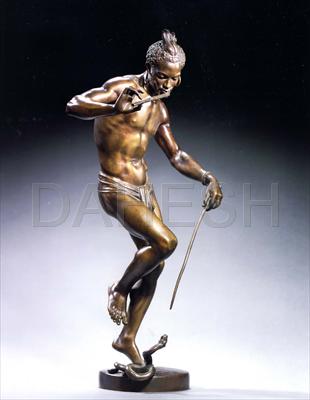Charles Arthur Bourgeois (French, 1838–1886)
The Snake Charmer, modeled 1863
Bronze, dark brown patina, 22 1/4 x 10 x 7 1/2 in.
Signed on base back center: ARTHUR BOURGEOIS Sculptr.
2002.49

Bourgeois won the Prix de Rome in 1863, the same year he created and exhibited the plaster version of The Snake Charmer. A year later, Emperor Napoleon III (reigned 1852–1870) ordered a life-size bronze which now stands in the Jardin des Plantes in Paris. The Snake Charmer would become one of Bourgeois’s most popular works, as confirmed by the many reductions that were made of it, like this one. The sculpture reflects the wide-ranging debate within academic art that revolved around the dominance of the classical ideal. Several artists attempted to expand the notion of the classical ideal by, for example, depicting Africans and other people of color. The critic de Rialle discussed this and similar works at the 1863 Salon as follows: “One begins to divert from the academic errors by making ethnographic sculpture […]. It introduces art to a new field, namely science and thus to the idea; then it opens new horizons by giving new subjects and reveals beauty in all its aspects and in all climates; finally it generates a new poetry.”


